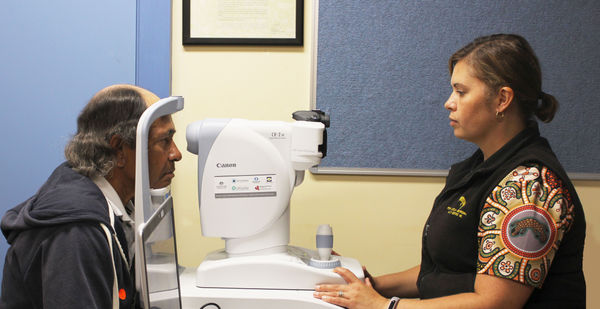Our Programs


The Eye Health Program works continually toward equitable, optimal and sustainable eye health and vision outcomes for Aboriginal people in South Australia.
The four most common eye and vision conditions among Aboriginal people are:
- Refractive Error – blurred vision correctable with glasses or contact lenses
- Cataracts – most common age-related vision loss, easily correctable with surgical procedure
- Diabetic Retinopathy – leading cause of preventable vision loss in Aboriginal working age adults
- Trachoma – highly contagious but treatable bacterial eye infection, causing public health issue
The prevalence rates, complexities and barriers are heightened in remote and far remote community locations. Issues include limited access to eye health practitioners, access to low or no cost prescription glasses, waiting lists for cataract surgeries, costly treatments such as intravitreal injections, and insufficient eye health coordination at local or regional levels, due mainly to lack of sector-wide funding.
The Eye Program aims to maintain good vision and healthy eyes for all Aboriginal people, and work cohesively with key players in the delivery of primary, secondary and tertiary level eye health and vision care, to collectively address the various barriers and issues including those listed above.
The Eye Health Project Officer (EHPO) is pivotal to this work with the sector, together with working closely and extensively with primary health staff and visiting eye practitioners alike at the local ACCHS interface.
The Eye Program / EHPO provides:
- support, capacity building, and advocacy to AHCSA’s Member health services in managing eye health and vision care at primary (clinic) and secondary (visiting services) levels, and strengthening patient pathways to tertiary level care (surgeries/treatments)
- ACCHS staff training in primary eye health care; vision testing; retinal photography and retinal screening; efficient documenting; streamlining eye care workflows and patient pathways
- guidance and mentoring in embedding vision testing and in-house retinal screening into clinic workflows and day-to-day patient care where appropriate, including child and adult health checks and care plans for chronic disease management, and maximising MBS claiming in the process
- streamlining clinic systems such as patient information management systems to best support eye care
- client access to low or no cost prescription glasses, external diagnostics and treatments
- assistance in the procurement, maintenance and use of specialised eye health equipment
- on-the-ground support for outreach eye health practitioner visits (optometrists and ophthalmologists) – including patient lists, client flow, equipment, documenting, fitting glasses, referrals and other follow ups.
Further Information
GlassesSA - Participating Optometrists
IEHU "Check Today, See Tomorrow" - About Diabetes Eye Care
IEHU - Roadmap to Close The Gap For Vision
Brien Holden Foundation - Provision of Eye Health Equipment & Training (PEHET) Project
Educational video "Bad Sugar, Bad Eyes" (Lions Outback Vision)

